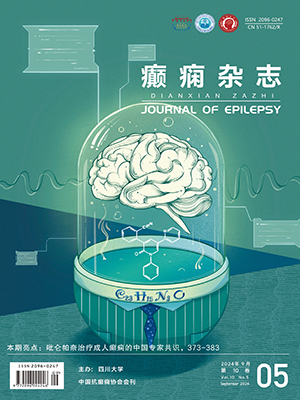| 1. |
Kwan P, Arzimanoglou A, Berg AT, et al. Definition of drug resistant epilepsy: consensus proposal by the ad hoc Task Force of the ILAE Commission on Therapeutic Strategies. Epilepsia, 2010, 51(6): 1069-1077.
|
| 2. |
Leo A, Giovannini G, Russo E, et al. The role of ampa receptors and their antagonists in status epilepticus. Epilepsia, 2018, 59(6): 1098-1108.
|
| 3. |
周永, 刘民, 梁万年. 癫痫流行病学研究进展. 中华流行病学杂志, 2007, 28(1): 92-94.
|
| 4. |
Fisher RS, Cross JH, French JA, et al. Operational classification of seizure types by the International League Against Epilepsy: Position Paper of the ILAE Commission for Classification and Terminology. Epilepsia, 2017, 58(Suppl.): 522-530.
|
| 5. |
张宇昕, 翟琼香, 汤志鸿, 等. 左乙拉西坦添加治疗小儿额叶癫痫: 附105例报告. 南方医科大学学报, 2014, (3): 364-367.
|
| 6. |
Krauss GL, Perucca E, Kwan P, et al. Final safety, tolerability, and seizure outcomes in patients with focal epilepsy treated with adjunctive perampanel for up to 4 years in an open-label extension of phase iii randomized trials: Study 307. Epilepsia, 2018, 59(4): 866-876.
|
| 7. |
褚思嘉, 汤继宏. 第三代新型ASMs吡仑帕奈在癫痫治疗中的研究进展. 癫痫杂志, 2021, 7(1): 58-61.
|
| 8. |
Pina-Garza JE, Rosenfeld W, Saeki K, et al. Efficacy and safety of adjunctive perampanel in adolescent patients with epilepsy: Post hoc analysis of six randomized studies. Epilepsy Behav, 2020: 104.
|
| 9. |
Rektor I, Krauss GL, Inoue Y, et al. Assessment of the long-term efficacy and safety of adjunctive perampanel in tonic-clonic seizures: Analysis of four open-label extension studies. Epilepsia, 2020, 61(7): 1491-1502.
|
| 10. |
Fogarasi A, Flamini R, Milh M, et al. Open-label study to investigate the safety and efficacy of adjunctive perampanel in pediatric patients (4 to < 12 years) with inadequately controlled focal seizures or generalized tonic-clonic seizures. Epilepsia, 2020, 61(1): 125-137.
|
| 11. |
Chen T, Dai SH, Jiang ZQ, et al. The AMPAR Antagonist perampanel attenuates traumatic brain injury through anti-oxidative and anti-inflammatory activity. Cell Mol Eurobiol, 2017, 37(1): 43-52.
|
| 12. |
Nishida T, Lee SK, Inoue Y, et al. Adjunctive perampanel in partial-onset seizures: Asia-pacific, randomized phase iii study. Acta Neurol Scand, 2018, 137(4): 392-399.
|
| 13. |
Ishikawa N, Tateishi Y, Tani H, et al. Clinical profiles associated with serum perampanel concentrations in children with refractory epilepsy. Epilepsy Behav, 2019, 94: 82-86.
|
| 14. |
Ikemoto S, Hamano S, Hirata Y, et al. Efficacy and serum concentrations of perampanel for treatment of drug-resistant epilepsy in children, adolescents, and young adults: comparison of patients younger and older than 12 years. Seizure-Eur J Epilep, 2019, 73: 75-78.
|
| 15. |
Hwang SK, Lee YJ, Nam SO, et al. Real-life effectiveness and tolerability of perampanel in pediatric patients aged 4 years or older with epilepsy: a Korean national multicenter study. J Clin Neurol, 2020, 16(1): 53-59.
|
| 16. |
褚思嘉, 汤继宏, 李岩, 等. 吡仑帕奈治疗儿童难治性癫痫的疗效和安全性研究. 癫痫杂志, 2021, 7(5): 385-391.
|
| 17. |
Trinka E, Steinhoff BJ, Nikanorova M, et al. Perampanel for focal epilepsy: Insights from early clinical experience. Acta Neurol Scand, 2016, 133(3): 160-172.
|




